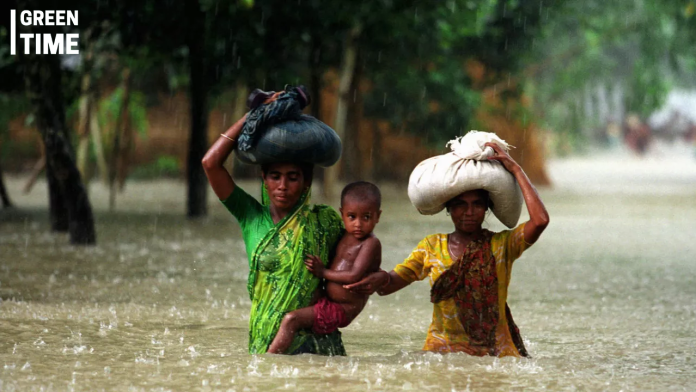Over 2 million children in eastern Bangladesh are at severe risk due to the ongoing floods that have inundated homes, schools, and entire villages. According to UNICEF, this flood is the worst to hit eastern Bangladesh in 34 years, affecting around 5.6 million people. A statement released today by UNICEF highlights the devastating impact of this unprecedented disaster, fueled by torrential monsoon rains that have caused major rivers in the southeast to overflow.
So far, over 52 people have lost their lives, and more than 500,000 people in the Chittagong and Sylhet divisions are seeking shelter. Floodwaters have submerged houses, roads, fields, and crops, leaving millions, including children, trapped without food or essential relief supplies. Despite ongoing rescue efforts by government officials and volunteers, delivering aid remains challenging in some areas due to the continuous monsoon rains, which are expected to cause further damage.
UNICEF’s Deputy Representative in Bangladesh, Emma Brigham, emphasized the severity of the situation, stating, “The flooding in eastern Bangladesh has highlighted the devastating impact of extreme weather events and the climate crisis on children. Many children have lost loved ones, homes, and schools, leaving them in a very vulnerable state.”
Since the disaster began, UNICEF has been actively providing emergency supplies, including water purification tablets and oral rehydration salts, to those affected. However, Brigham noted that more funding is urgently needed to reach every child and mitigate the ongoing crisis’s devastating impact on their future.
UNICEF has been on the ground since the disaster’s onset, conducting preliminary assessments in collaboration with Hasan Arif, an advisor to the Ministry of Local Government, Rural Development, and Cooperatives. So far, UNICEF has reached over 338,000 people, including 130,000 children, providing life-saving supplies such as 3.6 million water purification tablets, 25,000 jerry cans for water storage, and over 250,000 bags of oral rehydration salts.
Despite these efforts, UNICEF stresses that much more needs to be done. The organization calls for urgent cash assistance, safe drinking water, hygiene kits, emergency latrines, sanitary pads, oral rehydration salts, and life-saving medicines for affected children and families. It also highlights the need for primary healthcare services for sick newborns and children and essential services for pregnant women to safely deliver their babies.
This disaster comes in the wake of other recent emergencies, including northern Bangladesh’s floods and Cyclone Remal in May. Together, these three crises have affected over 13 million people, including 5 million children across Bangladesh.
To address these emergencies, UNICEF needs $35.3 million to support urgent life-saving and multi-sectoral interventions for affected children, pregnant women, and breastfeeding mothers. As climate change increases the frequency, intensity, and unpredictability of extreme weather events like cyclones and floods, Bangladesh and its people are facing unprecedented challenges, making the climate crisis fundamentally a children’s rights crisis. UNICEF’s Children’s Climate Risk Index ranks Bangladesh among the world’s most at-risk countries for climate and environmental hazards affecting children.

